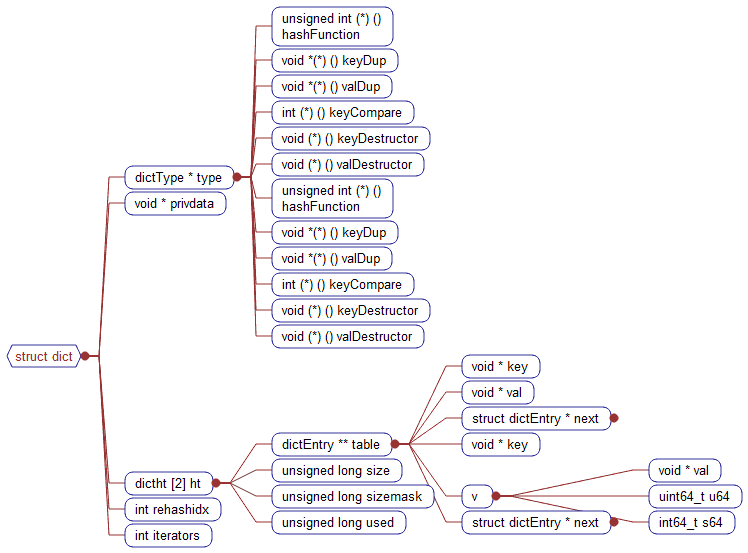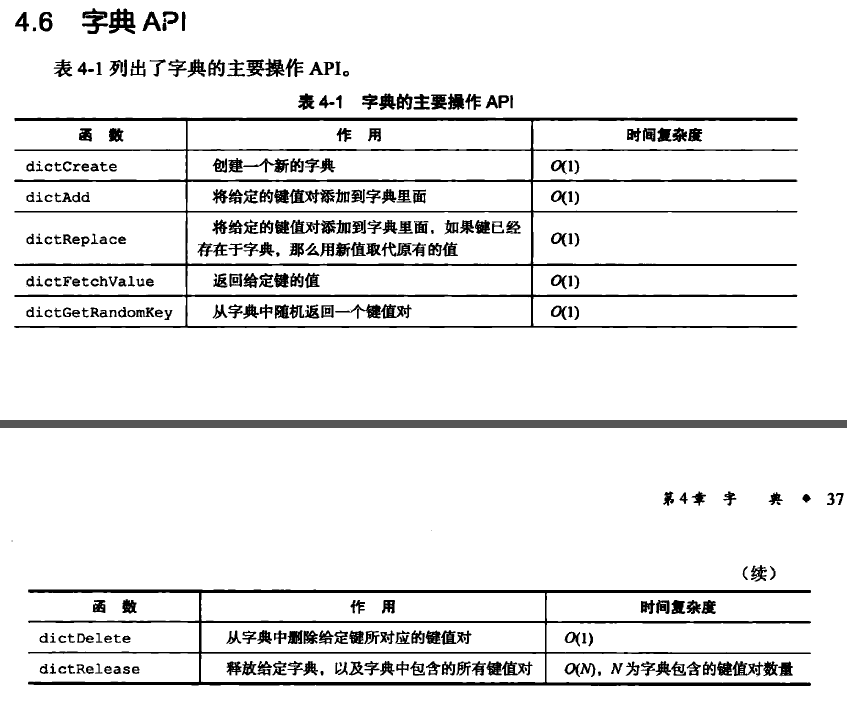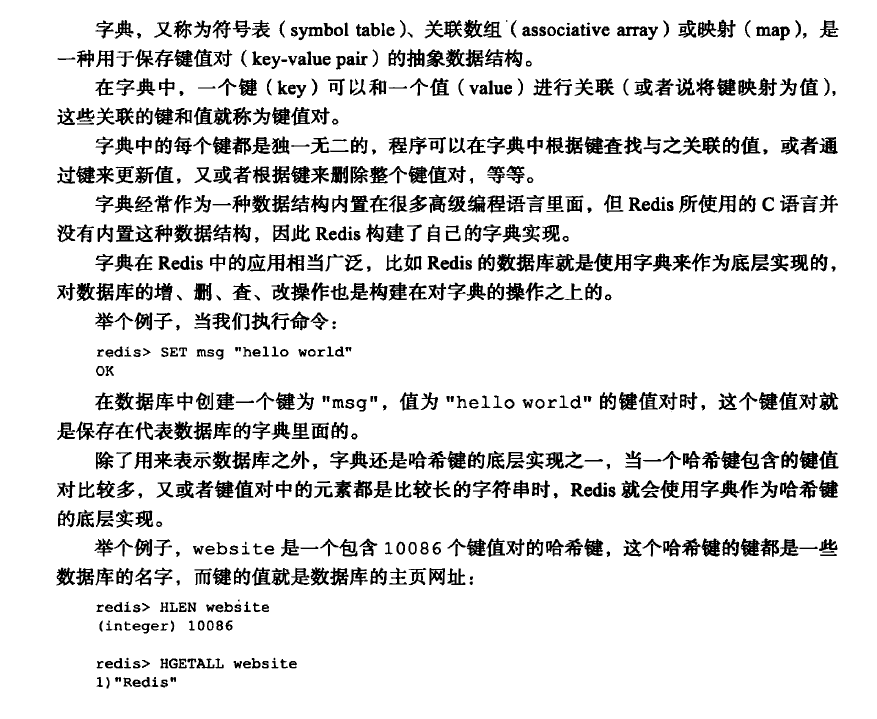简介
本节主要介绍redis的第三种主要数据类型字典。
本文介绍顺序
- 介绍redis字典的应用;
- 分析字典类的定义;
- 分析字典类各个属性的含义;
- 介绍字典类的主要API及功能;
- 分析字典类的代码实现。
介绍redis字典的应用
redis中字典的应用在《redis的设计与实现》一书中已经描述的十分清楚了。不过这里让手中没有书的朋友看一下此小节:
字典的定义
那么我们下面一起看一下代码src/dict.h
/*
* 字典
*/
typedef struct dict {
// 类型特定函数
dictType *type;
// 私有数据
void *privdata;
// 哈希表
dictht ht[2];
// rehash 索引
// 当 rehash 不在进行时,值为 -1
int rehashidx; /* rehashing not in progress if rehashidx == -1 */
// 目前正在运行的安全迭代器的数量
int iterators; /* number of iterators currently running */
} dict;图17
我们把上面的字典看做是OO中的一个类,该类中有4个属性和6个方法,我们一个一个来分析:
dictType *type
字典类型特定函数。为实现根据字典类型不同而多态操作的方法。它的定义如下图所示:
/*
* 字典类型特定函数
*/
typedef struct dictType {
// 计算哈希值的函数
unsigned int (*hashFunction)(const void *key);
// 复制键的函数
void *(*keyDup)(void *privdata, const void *key);
// 复制值的函数
void *(*valDup)(void *privdata, const void *obj);
// 对比键的函数
int (*keyCompare)(void *privdata, const void *key1, const void *key2);
// 销毁键的函数
void (*keyDestructor)(void *privdata, void *key);
// 销毁值的函数
void (*valDestructor)(void *privdata, void *obj);
} dictType;从上图可以看到,字典类的6个方法都是公有方法,可针对不同的字典键值对类型来进行多态。
* void *privdata
字典类用于多态的私有数据。更详细的下面继续分析。
- dictht ht[2]
这里的ht是一个哈希表数组,字典中存放两个哈希表。其中一个用于常规字典操作,一个用于rehash。我们先看一下哈希表的定义,在具体讨论两个哈希表在字典中的作用。
/* This is our hash table structure. Every dictionary has two of this as we
* implement incremental rehashing, for the old to the new table. */
/*
* 哈希表
* * 每个字典都使用两个哈希表,从而实现渐进式 rehash 。
*/
typedef struct dictht {
// 哈希表数组
dictEntry **table;
// 哈希表大小
unsigned long size;
// 哈希表大小掩码,用于计算索引值
// 总是等于 size - 1
unsigned long sizemask;
// 该哈希表已有节点的数量
unsigned long used;
} dictht;图19
在这个图中我们看到哈希表共有四个属性:
* 属性table
是一个指针数组,数组中每一个元素都指向一个哈希表节点的指针。我们在这里先看一下哈希表节点的定义:
/*
* 哈希表节点
*/
typedef struct dictEntry {
// 键
void *key;
// 值
union {
void *val;
uint64_t u64;
int64_t s64;
} v;
// 指向下个哈希表节点,形成链表
struct dictEntry *next;
} dictEntry;图20
在哈希表的节点中实际存储着键值对。Key属性保存着哈希表的键,v属性保存着哈希表的值。有三种数据类型的值,一个指向值的指针,或一个uint64_t类型的整数,或一个int64_t类型的整数。
* 属性size
属性size记录哈希表的大小。
- 属性sizemask
属性sizemask总等于size -1,用于计算哈希表的索引值
- 属性used
该哈希表已有节点的数量。注意这里不是指哈希表中已经使用的桶的数量,而是指哈希表中实际键值对的数量。
- int rehashidx
此变量表示当前rehash进行在dict->ht[0]中已经rehash的桶号(rehash按照从头至尾的过程)。的主要用于渐进式rehash(渐进式rehash在后续小节中描述)。此变量为-1时,表示哈希表未进行rehash。
总结:
通过上面的描述大家可能还有点晕,下面我用一张数据成员图来描述字典类:

数据成员图
2.3.1.字典的实现
在实现的部分,我们将详细的分析字典的API方法:
首先我们看一下字典的常用API:

创建一个新的字典
/*
* 字典的操作状态
*/
// 操作成功
#define DICT_OK 0
// 操作失败(或出错)
#define DICT_ERR 1
/* Reset a hash table already initialized with ht_init().
* NOTE: This function should only be called by ht_destroy(). */
/*
* 重置(或初始化)给定哈希表的各项属性值
*
* p.s. 上面的英文注释已经过期
*
* T = O(1)
*/
static void _dictReset(dictht *ht)
{
ht->table = NULL;
ht->size = 0;
ht->sizemask = 0;
ht->used = 0;
}
/* Create a new hash table */
/*
* 创建一个新的字典
*
* T = O(1)
*/
dict *dictCreate(dictType *type,
void *privDataPtr)
{
dict *d = zmalloc(sizeof(*d));
_dictInit(d,type,privDataPtr);
return d;
}
/* Initialize the hash table */
/*
* 初始化哈希表
*
* T = O(1)
*/
int _dictInit(dict *d, dictType *type,
void *privDataPtr)
{
// 初始化两个哈希表的各项属性值
// 但暂时还不分配内存给哈希表数组
_dictReset(&d->ht[0]);
_dictReset(&d->ht[1]);
// 设置类型特定函数
d->type = type;
// 设置私有数据
d->privdata = privDataPtr;
// 设置哈希表 rehash 状态
d->rehashidx = -1;
// 设置字典的安全迭代器数量
d->iterators = 0;
return DICT_OK;
}
初始化字典的操作没有多少特殊的。完成以下几个步骤:
- 分配字典的内存
- 初始化两个哈希表(不分配哈希表空间);
- 设置哈希表的公共方法和私有数据;
- 设置字典的rehash状态为-1;(rehash的作用后续详细讨论)
- 设置安全迭代器的属性为0;
尝试将给定键值对添加到字典中
/* Add an element to the target hash table */
/*
* 尝试将给定键值对添加到字典中
* * 只有给定键 key 不存在于字典时,添加操作才会成功
* * 添加成功返回 DICT_OK ,失败返回 DICT_ERR
* * 最坏 T = O(N) ,平滩 O(1)
*/
int dictAdd(dict *d, void *key, void *val)
{
// 尝试添加键到字典,并返回包含了这个键的新哈希节点
// T = O(N)
dictEntry *entry = dictAddRaw(d,key);
// 键已存在,添加失败
if (!entry) return DICT_ERR;
// 键不存在,设置节点的值
// T = O(1)
dictSetVal(d, entry, val);
// 添加成功
return DICT_OK;
}由上面代码可以看到,将添加一个键值对分为了两步:
- dictAddRaw:如果键不存在,返回该键所在的桶
dictSetVal:设置值
这块代码注释的很清楚了,我就不多废话了,我们先看一下dictAddRaw的实现吧:
/* Low level add. This function adds the entry but instead of setting
* a value returns the dictEntry structure to the user, that will make
* sure to fill the value field as he wishes.
*
* This function is also directly exposed to user API to be called
* mainly in order to store non-pointers inside the hash value, example:
*
* entry = dictAddRaw(dict,mykey);
* if (entry != NULL) dictSetSignedIntegerVal(entry,1000);
*
* Return values:
*
* If key already exists NULL is returned.
* If key was added, the hash entry is returned to be manipulated by the caller.
*/
/*
* 尝试将键插入到字典中
*
* 如果键已经在字典存在,那么返回 NULL
*
* 如果键不存在,那么程序创建新的哈希节点,
* 将节点和键关联,并插入到字典,然后返回节点本身。
*
* T = O(N)
*/
dictEntry *dictAddRaw(dict *d, void *key)
{
int index;
dictEntry *entry;
dictht *ht;
// 如果条件允许的话,进行单步 rehash
// T = O(1)
if (dictIsRehashing(d)) _dictRehashStep(d);
/* Get the index of the new element, or -1 if
* the element already exists. */
// 计算键在哈希表中的索引值
// 如果值为 -1 ,那么表示键已经存在
// T = O(N)
if ((index = _dictKeyIndex(d, key)) == -1)
return NULL;
// T = O(1)
/* Allocate the memory and store the new entry */
// 如果字典正在 rehash ,那么将新键添加到 1 号哈希表
// 否则,将新键添加到 0 号哈希表
ht = dictIsRehashing(d) ? &d->ht[1] : &d->ht[0];
// 为新节点分配空间
entry = zmalloc(sizeof(*entry));
// 将新节点插入到链表表头
entry->next = ht->table[index];
ht->table[index] = entry;
// 更新哈希表已使用节点数量
ht->used++;
/* Set the hash entry fields. */
// 设置新节点的键
// T = O(1)
dictSetKey(d, entry, key);
return entry;
}这个的英文注释还是写的很清晰的。
总结下来这个函数就是完成以下流程:
1.如果条件允许的话,进行单步 rehash;
2.判断键是否存在并计算键在哈希表中的索引值;
3.如果字典正在 rehash ,那么将新键添加到 1 号哈希表;
4.为新节点分配空间,并将新节点插入到链表表头。将新节点插入表头的原因是字典中没有指向桶表尾的指针,所以将新的冲突的节点放在哈希表的表头;
5.更新哈希表已使用节点数量;
6.设置新节点的键。
这里我们再分析一下步骤1中的单步rehash
/* This function performs just a step of rehashing, and only if there are
* no safe iterators bound to our hash table. When we have iterators in the
* middle of a rehashing we can't mess with the two hash tables otherwise
* some element can be missed or duplicated.
*
* 在字典不存在安全迭代器的情况下,对字典进行单步 rehash 。
*
* 字典有安全迭代器的情况下不能进行 rehash ,
* 因为两种不同的迭代和修改操作可能会弄乱字典。
*
* This function is called by common lookup or update operations in the
* dictionary so that the hash table automatically migrates from H1 to H2
* while it is actively used.
*
* 这个函数被多个通用的查找、更新操作调用,
* 它可以让字典在被使用的同时进行 rehash 。
*
* T = O(1)
*/
static void _dictRehashStep(dict *d) {
if (d->iterators == 0) dictRehash(d,1);
}
/* Performs N steps of incremental rehashing. Returns 1 if there are still
* keys to move from the old to the new hash table, otherwise 0 is returned.
*
* 执行 N 步渐进式 rehash 。
*
* 返回 1 表示仍有键需要从 0 号哈希表移动到 1 号哈希表,
* 返回 0 则表示所有键都已经迁移完毕。
*
* Note that a rehashing step consists in moving a bucket (that may have more
* than one key as we use chaining) from the old to the new hash table.
*
* 注意,每步 rehash 都是以一个哈希表索引(桶)作为单位的,
* 一个桶里可能会有多个节点,
* 被 rehash 的桶里的所有节点都会被移动到新哈希表。
*
* T = O(N)
*/
int dictRehash(dict *d, int n) {
// 只可以在 rehash 进行中时执行
if (!dictIsRehashing(d)) return 0;
// 进行 N 步迁移
// T = O(N)
while(n--) {
dictEntry *de, *nextde;
/* Check if we already rehashed the whole table... */
// 如果 0 号哈希表为空,那么表示 rehash 执行完毕
// T = O(1)
if (d->ht[0].used == 0) {
// 释放 0 号哈希表
zfree(d->ht[0].table);
// 将原来的 1 号哈希表设置为新的 0 号哈希表
d->ht[0] = d->ht[1];
// 重置旧的 1 号哈希表
_dictReset(&d->ht[1]);
// 关闭 rehash 标识
d->rehashidx = -1;
// 返回 0 ,向调用者表示 rehash 已经完成
return 0;
}
/* Note that rehashidx can't overflow as we are sure there are more
* elements because ht[0].used != 0 */
// 确保 rehashidx 没有越界
assert(d->ht[0].size > (unsigned)d->rehashidx);
// 略过数组中为空的索引,找到下一个非空索引
while(d->ht[0].table[d->rehashidx] == NULL) d->rehashidx++;
// 指向该索引的链表表头节点
de = d->ht[0].table[d->rehashidx];
/* Move all the keys in this bucket from the old to the new hash HT */
// 将链表中的所有节点迁移到新哈希表
// T = O(1)
while(de) {
unsigned int h;
// 保存下个节点的指针
nextde = de->next;
/* Get the index in the new hash table */
// 计算新哈希表的哈希值,以及节点插入的索引位置
h = dictHashKey(d, de->key) & d->ht[1].sizemask;
// 插入节点到新哈希表
de->next = d->ht[1].table[h];
d->ht[1].table[h] = de;
// 更新计数器
d->ht[0].used--;
d->ht[1].used++;
// 继续处理下个节点
de = nextde;
}
// 将刚迁移完的哈希表索引的指针设为空
d->ht[0].table[d->rehashidx] = NULL;
// 更新 rehash 索引
d->rehashidx++;
}
return 1;
}
更多rehash细节和策略,在《redis设计与实现》中已经说的很清楚,这里就不多说了。
其它的几个API函数也没有太多特殊的,这里我要重复强调的一点是:
redis字典采用渐进式rehash将rehash操作,平摊到增删改查的各个步骤。使时间复杂度为O(1)的做法。是我们值得学习的。
rehash的详细步骤,请参照《redis设计与实现》。
这篇笔记就写到这里,请多指教。























 794
794

 被折叠的 条评论
为什么被折叠?
被折叠的 条评论
为什么被折叠?








